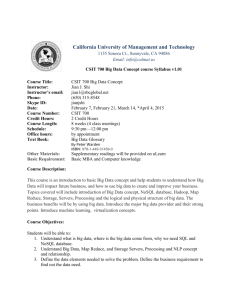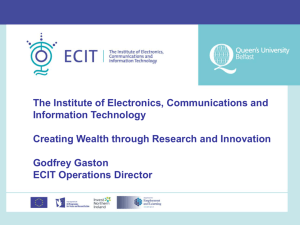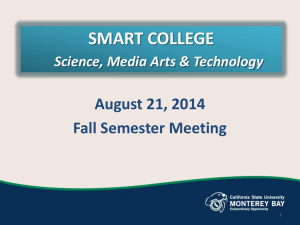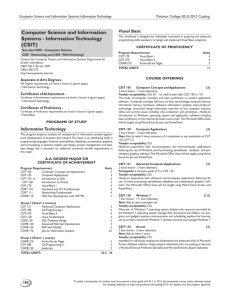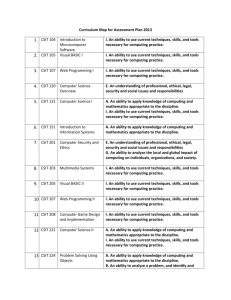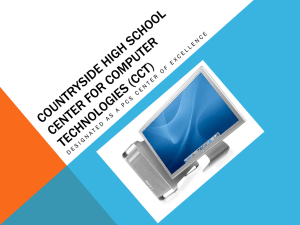The Cognitive Representation of Computer-Supported Instructional Tools Alessandro Antonietti ()
advertisement
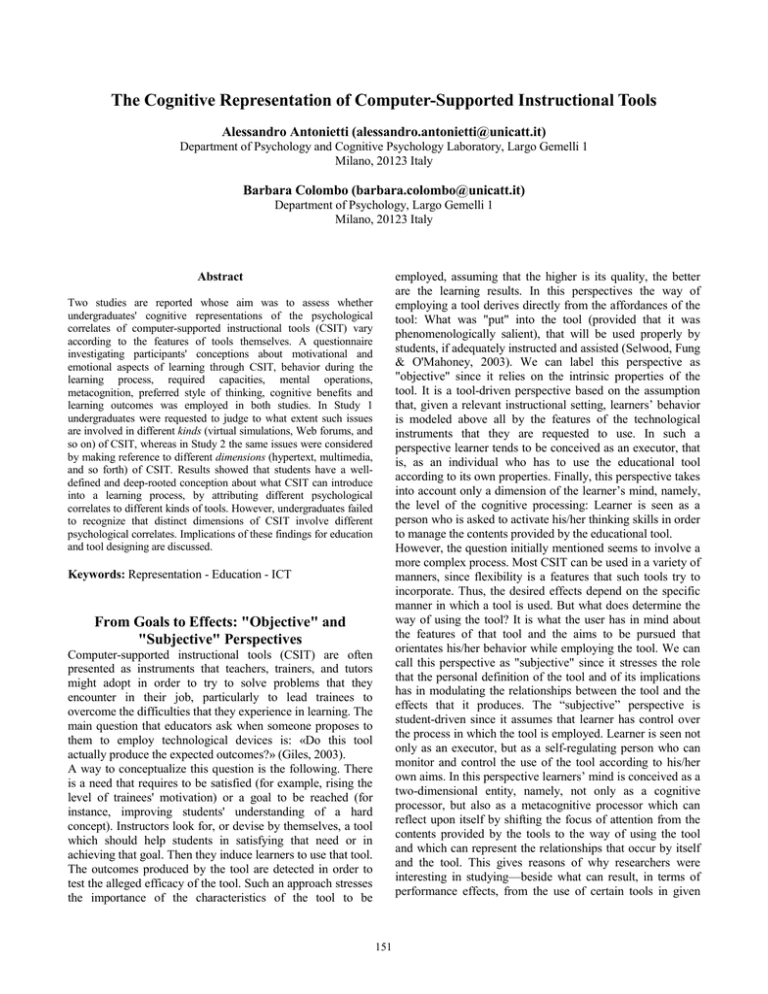
The Cognitive Representation of Computer-Supported Instructional Tools Alessandro Antonietti (alessandro.antonietti@unicatt.it) Department of Psychology and Cognitive Psychology Laboratory, Largo Gemelli 1 Milano, 20123 Italy Barbara Colombo (barbara.colombo@unicatt.it) Department of Psychology, Largo Gemelli 1 Milano, 20123 Italy employed, assuming that the higher is its quality, the better are the learning results. In this perspectives the way of employing a tool derives directly from the affordances of the tool: What was "put" into the tool (provided that it was phenomenologically salient), that will be used properly by students, if adequately instructed and assisted (Selwood, Fung & O'Mahoney, 2003). We can label this perspective as "objective" since it relies on the intrinsic properties of the tool. It is a tool-driven perspective based on the assumption that, given a relevant instructional setting, learners’ behavior is modeled above all by the features of the technological instruments that they are requested to use. In such a perspective learner tends to be conceived as an executor, that is, as an individual who has to use the educational tool according to its own properties. Finally, this perspective takes into account only a dimension of the learner’s mind, namely, the level of the cognitive processing: Learner is seen as a person who is asked to activate his/her thinking skills in order to manage the contents provided by the educational tool. However, the question initially mentioned seems to involve a more complex process. Most CSIT can be used in a variety of manners, since flexibility is a features that such tools try to incorporate. Thus, the desired effects depend on the specific manner in which a tool is used. But what does determine the way of using the tool? It is what the user has in mind about the features of that tool and the aims to be pursued that orientates his/her behavior while employing the tool. We can call this perspective as "subjective" since it stresses the role that the personal definition of the tool and of its implications has in modulating the relationships between the tool and the effects that it produces. The “subjective” perspective is student-driven since it assumes that learner has control over the process in which the tool is employed. Learner is seen not only as an executor, but as a self-regulating person who can monitor and control the use of the tool according to his/her own aims. In this perspective learners’ mind is conceived as a two-dimensional entity, namely, not only as a cognitive processor, but also as a metacognitive processor which can reflect upon itself by shifting the focus of attention from the contents provided by the tools to the way of using the tool and which can represent the relationships that occur by itself and the tool. This gives reasons of why researchers were interesting in studying—beside what can result, in terms of performance effects, from the use of certain tools in given Abstract Two studies are reported whose aim was to assess whether undergraduates' cognitive representations of the psychological correlates of computer-supported instructional tools (CSIT) vary according to the features of tools themselves. A questionnaire investigating participants' conceptions about motivational and emotional aspects of learning through CSIT, behavior during the learning process, required capacities, mental operations, metacognition, preferred style of thinking, cognitive benefits and learning outcomes was employed in both studies. In Study 1 undergraduates were requested to judge to what extent such issues are involved in different kinds (virtual simulations, Web forums, and so on) of CSIT, whereas in Study 2 the same issues were considered by making reference to different dimensions (hypertext, multimedia, and so forth) of CSIT. Results showed that students have a welldefined and deep-rooted conception about what CSIT can introduce into a learning process, by attributing different psychological correlates to different kinds of tools. However, undergraduates failed to recognize that distinct dimensions of CSIT involve different psychological correlates. Implications of these findings for education and tool designing are discussed. Keywords: Representation - Education - ICT From Goals to Effects: "Objective" and "Subjective" Perspectives Computer-supported instructional tools (CSIT) are often presented as instruments that teachers, trainers, and tutors might adopt in order to try to solve problems that they encounter in their job, particularly to lead trainees to overcome the difficulties that they experience in learning. The main question that educators ask when someone proposes to them to employ technological devices is: «Do this tool actually produce the expected outcomes?» (Giles, 2003). A way to conceptualize this question is the following. There is a need that requires to be satisfied (for example, rising the level of trainees' motivation) or a goal to be reached (for instance, improving students' understanding of a hard concept). Instructors look for, or devise by themselves, a tool which should help students in satisfying that need or in achieving that goal. Then they induce learners to use that tool. The outcomes produced by the tool are detected in order to test the alleged efficacy of the tool. Such an approach stresses the importance of the characteristics of the tool to be 151 phenomenon in itself (that is, as a cognitive representation which accompanies computer use) and as a factor which can influences e-learning. settings (Bryant & Zillman, 2002; DiSessa, 2000)—also what learners think of the CSIT that they are proposed to use. The Cognitive Representation An Instrument to Assess the Cognitive Representation Various levels of the subjective reactions in which we are interested have to be distinguished. We can identify a first level which includes affective responses (pleasure, anxiety, frustration), feelings (self-confidence, interest) and perceptions (sense of competence, self-efficacy) (Gordon, Killey, Shevlin, McIlroy & Tierney, 2003). Dispositions (curiosity, refusal, acceptance) toward the CSIT (Yaghi, 1997) can be placed at a second level. A third level consists of opinions or naive conceptions about the tools (their importance, skills required, strategies to be employed). The first level concerns the direct, often unreflecting, response to the tool. The second level goes beyond the affective reactions and includes a motivational orientation, an (at least partially) controlled, even though not always completely explicit, tendency to do (or not to do) something with the tool. The third level embraces the beliefs that an individual develops about the tool, so constituting the personal cognitive representation of the tool (Wilson & Whitelock, 1998). As far as the third, above mentioned level is concerned, it is proved that students can catch and report differences between traditional and technology-based testing (Richardson et al., 2002) and training (Antonietti, Rasi, Imperio & Sacco, 2000) tools. University students are convinced that computers are necessary in school life, that they can enhance academic performance and that the Web helps to find information, makes communication easier, and has potential as a learning tool (Liaw, 2002). Undergraduates are aware of what motivates them in a Web-based course (Gao & Lehman, 2003), have precise ideas about the strengths and weaknesses of e-learning, and can conceptualize the benefits which are likely to be expected (Wilson & Whitelock, 1998). In general undergraduates can assess the nature, the reliability, and the strategies to access information in the Web (Dinet, Marquet & Nissen, 2003) and can relate learning outcomes to the level of interactivity experienced during the course (Jiang & Ting, 2000). Undergraduates engaged in instructional activities carried out within a virtual learning environment conceived that such a kind of environment was very flexible in terms of place and time and of setting pace of work and appreciated the responsibility for their learning (Richardson, 2001). The studies mentioned above showed that heterogeneous issues have been considered, so making difficult to draw a systematic view of students' cognitive representations. Thus, we decided to restrict our attention only onto a type of content of the students' naive conceptions, namely, the psychological correlates of CSIT. A correlate was considered as psychological if it matched two criteria: (i) it referred to a mental state, process, strategy, function, or skill; (ii) it referred to individual, but not social, abilities, preferences, or effects. Such a topic, as yet scarcely considered, concerns what computers introduce specifically, in terms of what happens in the learner’s mind, into the learning process and thus it seemed to us worthy to be investigated both as a A questionnaire was devised to investigate people's conceptions about the psychological correlates of CSIT. Item of the questionnaire concerned these issues: motivational and emotional aspects of learning (e.g., attraction, involvement, reactivity, boredom, tiredness), behavior during the learning process (active participation, effort), required capacities (attention, language, logical reasoning, creativity, quick reflexes, manual ability), mental processes (comparing, simultaneous consideration, schematizing, reflection, reelaborating, assuming other people's point of view), metacognition (planning, awareness of personal limits), preferred style of thinking (intuition, visualisation, reflection), cognitive benefits and learning outcomes (better understanding, immediate feedback, memorisation, application, overall view, confusion). Previous studies showed similar structures of the questionnaire. In Antonietti and Giorgetti’s (2004) Study 2 the questionnaire was filled out by 170 undergraduates. Factor analysis led to extract the following components. Factor 1 included items concerning the cognitive reelaboration of the contents to be learned: The highest loads in this factor suggested that it refers to the idea that CSIT help students to schematize the contents, to re-arrange them in order to have an overall picture, and to make links among them. Factor 2 was labelled as facilitating effects: CSIT allow students to learn fast and without effort and facilitate the application of the concepts, their memorisation and understanding. Factor 3 was loaded by items concerning analytical thinking: CSIT are suitable for persons who like reasoning in logical and schematic ways and ask for concentration and for the overall consideration of the given elements. Factor 4 included the negative aspects of CSIT: mental confusion, excessive involvement, tiredness, imprecision. Items related to creativity—which appeared to be associated with non-linguistic skills—loaded Factor 5. Finally, Factor 6 was labelled as curiosity since items concerning the attractive, not-boring properties of CSIT— which are appreciated by persons with a visual cognitive style—had the highest load on this factor. The investigation was replicated with 493 undergraduates (Giorgetti & Antonietti, in press). In this study Factor 1 corresponded to creativity skills (intuition, fantasy, simultaneous consideration, quick reflexes, prevision, perceptual performance, risk taking). Factor 2 was linked to the optimising and facilitating effects of CSIT (implicit and visual learning, memorisation, convincing effects, boredom contrasting). Factor 3 was loaded by items stressing the involvement of analytical thinking (logic, schematising, planning, connecting, global view). Factor 4 included statements about the negative effects of CSIT. 152 forums, in which he/she is constantly requested to react to the threads proposed by other people participating in the discussion and to elaborate by himself/herself the responses or the questions to introduce in the debate (Selinger & Pearson, 1999). Hypertexts and Web forums are based exclusively, or prevalently, on the verbal code since they ask students to read words and to write sentences. By contrast, different codes are massively involved in other computersupported educational devices. Multimedia presentations integrate verbal language with iconic symbols (pictures, movies, and so on), sometimes supported also by sounds and music (Rouet, Levonen & Biardeau, 2001). Iconic representations, providing the illusion of threedimensionality, are on the basis also of virtual simulations, which immerse the learner in a artificial environment where he/she can move objects, generate phenomena, modify the variables of a given system, and so on (Stanny, 2002). Multimedia presentations tend to be associated with a passive fruition by the student, who watches (or listens to) what the tool is providing to him/her, whereas virtual simulations tend to assign an active role to the learner since he/she can act in the artificial situation yielded by the computer. These four kinds of instructional tools (hypertexts, Web forums, multimedia presentations, and virtual simulations) seem to represent a series of prototypal computer-supported devices, each of them subsuming a set of specific features, which can be meant as instances useful to assess whether students are able to differentiate their beliefs about the psychological aspects of the technological instruments that they are proposed to use in education. The questionnaire was administered to 99 undergraduates attending the Faculty of Engineering at the Voronezh Division of Russian State Open Technical University of Railway Transportation. Eighty-six students were enrolled in specialization courses in the field of construction of railways and the remaining 13 in specialization courses in the field of civil engineering. They were 72 men and 27 women ranging in age between 18 and 50 (mean age = 28.79 yrs., SD = 7.23). Men (mean age = 29.90 yrs., SD = 6.45) were older than women (mean age = 25.81 yrs., SD = 8.42; t(97) = 2.58, p < .05). Participants were given a booklet. In the first sheet of the booklet, which reported also the description of the aim of the questionnaire and the instructions to fill it out, respondents were requested to express their opinions about the psychological correlates of online courses. In each of the other four sheets they were asked to endorse the same list of items by making reference to hypertexts, Web forums, multimedia presentations, and virtual simulations employed for instructional aims. The order of these four kinds of tools was randomly varied in each booklet. A short description of each kind of educational tools was reported at the top of the corresponding sheet. Inspections of the distributions of responses in each item of the questionnaire revealed that, for each statement and for each kind of tools, the full range of possible responses was endorsed, so suggesting that the statements included in the questionnaire were discriminative for all kinds of CSIT. It The same questionnaire was administered also to 272 teachers (Antonietti & Giorgetti, in press). The relative degrees of importance attributed to the various psychological aspects of CSIT by teachers were rather similar to those attributed by students in the previous studies. Factor analysis induced us to label the resulting factors as follows. Factor 1 concerned analytical processes: CSIT were related to logical, schematic, holistic, associative, strategic reasoning. Factor 2 was loaded by items about creativity and about activation and attraction. Factors 3 made reference to facilitating effects: CSIT were perceived to make application, memorisation, and comprehension easier, thanks also to the reduction of time and of effort, to simultaneous thoughts, and to the reduction of verbal load. Factor 4 concerned the impact effects of CSIT, that is, visual and global understanding and arousing and convincing presentation of the contents. Factor 5 included the negative effects of CSIT: confusion, excessive involvement, tiredness, and imprecision. The overall consideration of these factor analyses suggested that recurrent patterns of beliefs lie under people's representation of the psychological correlates of educational information technologies. Negative effects, facilitating effects, analytical thinking, and creativity emerged as distinctive factors in all the studies. In these studies only a kind of tool at a time was considered. However, we realize that nowadays undergraduates have access to a variety of CSIT. Therefore we can assume that conceiving differences among tools is important both to select the most relevant tool in consideration of the goal to be reached and to use the chosen tool in the proper way. Thus, we were interested in assessing whether university students can differentiate their cognitive representations, as measured by the questionnaire described earlier, according to specific type of CSIT. Study 1 The aim of the study was to assess whether students can realize that psychological correlates of CSIT differ according to the kind of tools at hand. Five categories of tools were identified. Online courses can be conceived to be the general kind of tools in which we were interested. Online courses constitute a form of e-learning which is largely spread out around the world and are “containers” which can include a wide set of more specific tools (Rudestam & SchoenholtzRead, 2002). So, online courses served as a sort of pivotal point of reference to which more specific kinds of tools can be compared. Four main kinds have been considered here. Hypertexts are often proposed as tools which allow learner to access knowledge according to his/her preferences since they present contents organised within an associative framework which permits to overwhelm the sequential constraints of the usual linear structures shared by several traditional instruments (Bromme & Stahl, 2002). The fruition of hypertexts is usually passive, in the sense that students receive information provided by someone else, having only the possibility to choose what piece of information they like to acquire. An active role is assigned to the learner by Web 153 The questionnaire was filled out by 87 undergraduates attending different faculties (architecture, economics, education, science) in universities in the city of Milano (Italy). Also in this participants were given a booklet consisting of three sheets; In each sheet respondents were requested to express their opinions about the psychological correlates of, respectively, hypertext, multimedia, and interactive CSIT. The order of these three dimensions was randomly varied in each booklet. According to students’ opinions, multimedia tools are helpful above all to facilitate understanding, memorization and schematization; Hypertexts were appreciated since they allow learners, besides to better memorize, to make comparisons and to have a global view; Interactive tools were appreciated since they, beside facilitate concept schematization, force learners to be active and to apply what they were taught. So, it appears that undergraduates can perceive a few specific advantages provided by different features of CSIT, even though overlappings among some of the most and less appreciated features occurred. Possible significant differences among the three dimensions (hypertextuality, multimediality, and interactivity) were assessed through a one-way, repeated measure model of Analysis of Variance. Only in 7 out of 37 cases statistical significant differences among scores emerged. Thus, we are induced to maintain that students-even though they ranked psychological correlates of CSIT in a relative different order according to the fact that such correlates concern multimedia, hypertext, or interactive toolsfailed to attribute different absolute values to such correlates. This finding was supported by the computation of the correlations between scores of each pair of kinds of tool: In most cases significant correlations occurred. Thus, it resulted that undergraduates were not able to differentiate their judgments according to the specific dimension of CSIT. was possible to identify the psychological correlates of each kind of tools that were shared by undergraduates in the largest and lowest extent and to compare the five kinds of tools in order to assess whether the statements which were endorsed in the highest and lowest extent were or were not the same for all the kinds of tools. Data showed that—even though some features were, respectively, highly (e.g., involvement, manual abilities) or scarcely (activation, precision, boredom) attributed to more than one kind of tool—online courses, hypertexts, Web forums, multimedia presentations, and virtual simulations were characterized, in students’ cognitive representation, by distinctive features. Online courses were appreciated above all for their motivating and challenging power. Hypertexts were conceived as tools useful to a “serious” and deep learning, with no contribution from imagination. Multimedia presentations shared some features with hypertexts (notion re-elaboration, global view), even if incidental learning and facilitation in retention were attributed to the latter but not to the former ones. Specific aspects of social interaction were identified in Web forums. Finally, a visual, not-linguistic, and creative way of thought was attributed to virtual simulations. As far as each statement was concerned, possible significant differences among the five kinds of tools were assessed through a one-way, repeated measure model of Analysis of Variance: Significant differences among the kinds of CSIT emerged in 32 out of 37 cases (F values computed for each item of the questionnaire ranged from 3.21 to 32.06). Such a finding was supported by the computation, of the correlations between scores of each pair of kinds of tools. Even though in most cases significant positive correlations occurred, it is worth noticing that only in few cases coefficients were high. Study 2 A different, more sophisticated criterion to differentiate CSIT was used in this study. In Study 1 students were requested to consider different types of tools, defined on the basis of concrete, physical, perceptual and/or operational properties. In the present study they were requested to consider different dimensions—that is, properties defined at an abstract or functional level—of CSIT by making references, separately, to the following three dimensions: hypertextuality, multimediality, and interactivity. In other words, students were requested to judge to what extent each psychological correlate considered in the questionnaire depended on, respectively, the fact that CSIT (i) allow learners to personalise access to knowledge since contents are organised in a reticular manner so to permit people to choose the parts which meet their interests or needs and to move from a part to another without being compelled to follow a fixed, sequential order of presentation (hypertextuality), (ii) provide notions through two sensory channels (visual and auditory) and/or by means of a variety of codes or languages (multimediality), (iii) engage students into a continuous interchange of requestresponse-feedback, for instance by asking them to answer questions, to solve problems, to find hidden objects, to combine shapes, and so forth (interactivity). Conclusions The overall picture that emerged from the two studies carried out was that students have a well-defined and deep-rooted conception about what CSIT can introduce into a learning process, by attributing different psychological correlates to different kinds of tools. However, undergraduates failed to recognize that distinct features of CSIT involve different psychological correlates (or involve them to a different extent); In fact, participants tended to attribute similar effects to hypertextuality, multimediality, and interactivity. Differences between the two studies, where the same questionnaire was employed, might be due to differences in the samples of participants: Engineering undergraduates, thanks to their course of study and/or to the higher exposure to technological devices, may be more sensitive to the differences existing among various kinds of tools. Alternatively, it is possible that differences depended on the issues that students were asked to evaluate. In Study 2 undergraduates were requested to answer by considering different dimensions rather than kinds of tools. Presumably differentiating “things” such as forums, three-dimensional 154 the participation in a Web-forum. The lack of awareness about these aspects might lead students to approach new instructional devices by assuming the same, a-specific attitudes and, consequently, either to neglect possible causes of failure or to ignore interesting potentialities offered by the technology. The results of the study induce to wonder whether well-focused interventions are needed to lead students to reject inadequate conceptions and to realize properties of the tools whose they are not aware. Educators are in charge to check, when they work in team, if they have the same opinions about the psychological aspects of the CSIT that they plan to employ in order to be sure that a coherent view is shared by them. Trainers are also asked to pay attention to what students think about the computersupported devices. Such an attention is important in order to verify whether what is relevant in the educators’ opinion is also relevant in the learners' opinion. Finally, software developers should know what potential users think of the kind of instructional tools that they are construing, so to reflect about possible lack of correspondences between the functions with which they equip the tools and learners’ expectations. It is not unlikely that software designers include into a tool opportunities —such as the possibility to shift from a representational format to another, to draw automatically a schematic overview of the structure of the contents to be learned, to follow an approach based on autonomous discoveries, and so on—which will be not recognized by users since they do not perceive that tool as relevant to provide those opportunities. simulations, and so on is easier than differentiating concepts such as interactivity, and so forth. Several perspectives stress the role that cognitive representations of the learning process and of the tools which are involved in it play in modulating learning itself. For instance, literature about metacognition showed that personal ideas concerning how the mind works (the so-called metacognitive knowledge) influence learning outcomes (Schraw & Moshman, 1995). Studies about the naïve theories of learning highlighted that students’ opinions about the personal purposes and the mental strategies to be adopted when they have to learn are associated to achievement (Lonka, Joram & Bryson, 1996). Also epistemological beliefs—that is, individual convictions about how knowledge is constructed and acquired—resulted to be linked to learning results (Hofer & Pintrich, 2002). Finally, according to various models of self-regulated learning, students’ conceptions of the emotional, motivational, and cognitive aspects of learning can influence learning itself (Boekaerts, Pintrich & Zeidner, 2000). These perspectives support the importance of investigating the opinions about the psychological correlates of CSIT. The two studies reported here helped us to better describe students' representations of CSIT by allowing us to understand to what extent such representations can be sensitive to the specific features of the tools. If we assume that—beside the chain of causal influences that link educational goals, features of the instrument to be employed to reach such goals, presumed way to use the instrument and learning outcomes (the “objective” perspective) —a parallel chain links the actual use of the tool to what learners think of the tool itself, especially of the mental activities underpinning the tool (the “subjective” perspective), we can argue that the "objective" and "subjective" perspectives are two perspectives each of them integrating the other one. The needs or goals set by the educators—and the corresponding desired outcomes— interact with the learners’ perception of their own needs and goals; The identification of the relevant tool carried out by instructors matches or mismatches students’ opinions about the tool (why it should be useful, what advantages should derive from its use, and so forth); The planned use of the tool is modulated by what learners think is the best way of employing it. Implications of the findings of the present study are threefold, since they have something to say to learners, trainers, and software developers. Nowadays students are faced to a variety of technological educational devices. In some cases they have the opportunity to choose among them. In these circumstances, in order to select the tool which is more adequate, they must be aware of what a certain kind of instruments involves in terms of mental work activated. But also when only a kind of tools is available, this awareness is important if tools should be used in a way consistent with the features of the tools themselves, the learner’s personal characteristics, and the task demands and the goals to be achieved. The amount and type of effort required by hypertext navigation is usually different from that needed by References Antonietti, A., & Giorgetti, M. (2004). Students’ conceptions about learning from multimedia. In H. Niegemann, R. Brünken, & D. Leutner (Eds.), Instructional design for multimedia learning (pp. 249-265). Münster-New York: Waxmann. Antonietti, A., & Giorgetti, M. (in press) Teachers’ beliefs about psychological aspects of learning through multimedia. Computers in Human Behavior. Antonietti, A., Rasi, C., Imperio, E., Sacco, M. (2000). The representation of virtual reality in education. Education and Information Technologies, 5, 317-327. Boekaerts, M., Pintrich, P. R., & Zeidner, M. (Eds.) (2000). Handbook of self-regulation. San Diego, CA: Academic Press. Bromme, R., & Stahl, E. (Eds.) (2002). Writing hypertext and learning. Conceptual and empirical approaches. Amsterdam: Elsevier. Bryant, J., & Zillman, D. (Eds.) (2002). Media effects. Advances in theory and research. Mahwah, NJ: Lawrence Erlbaum Associates. Dinet, J., Marquet, P., & Nissen, E. (2003). An exploratory study of adolescent's perceptions of the Web. Journal of Computer Assisted Learning, 19, 538-545. DiSessa, A. A. (2000). Changing minds: Computers, learning, and literacy. Cambridge, MA: MIT Press. 155 Richardson, M., Baird, J.-A., Ridgway, J., Ripley, M., Shorrocks-Taylor, D., & Swan, M. (2002). Challenging minds? Students’ perceptions of computer-based World Class Tests of problem solving. Computers in Human Behavior, 18, 633-649. Rouet, J. F., Levonen, J. J., & Biardeau, A. (Eds.) (2001). Multimedia learning: Cognitive and instructional issues. Amsterdam: Pergamon. Rudestam, K., & Schoenholtz-Read, J. (Eds.) (2002). Handbook of online learning. London: Sage. Schraw, G., & Moshman, D. (1995). Metacognitive theories. Educational Psychology Review, 7, 351-371. Selinger, M., & Pearson, J. (Eds.) (1999). Telematics in education: Trends and issues. Amsterdam: Pergamon. Selwood, I. D., Fung, A. C. W., & O'Mahoney, C. D. (Eds.) (2003). Management of education in the information age. The role of ICT. New York: Kluwer. Stanny, K. M. (Ed.) (2002). Handbook of virtual environment: Design, implementation, and applications. Mahwah, NJ: Lawrence Erlbaum Associates. Wilson, T., & Whitelock, D. (1998). What are the perceived benefits of participating in a computer-mediated communication (CMC) environment for distance learning computer science students? Computers and Education, 30, 259-269. Yaghi, H. M. (1997). Pre-university students’ attitudes toward computers: An international perspective. Journal of Educational Computing Research, 16, 237-249. Gao, T. & Lehman, J. D. (2003). The effects of different levels of interaction on the achievement and motivational perceptions of college students in a Web-based learning environment. Journal of Interactive Learning Research, 14, 367-386. Giles, D. (2003). Media psychology. Mahwah, NJ: Lawrence Erlbaum Associates. Giorgetti, M. & Antonietti, A. (in press). Come gli studenti si rappresentano il ruolo della multimedialità nella formazione [How students conceive the role of multimedia in education], Rassegna di Psicologia. Gordon, M., Killey, M., Shevlin, M., McIlroy, D., & Tierney K. (2003). The factor structure of the Computer Anxiety Rating Scale and the Computer Thoughts Survey. Computers in Human Behavior, 19, 291-298. Hofer, B., & Pintrich, P. R. (2002). Personal epistemology. The psychology of beliefs about knowledge and knowing. Mahwah, NJ: Lawrence Erlbaum Associates. Jiang, M., & Ting, E. (2000). A study of factors influencing students' perceived learning in a Web-based course environment. International Journal of Educational Telecommunications, 6, 317-338. Liaw, S.-S. (2002). An Internet survey for perceptions of computers and the World Wide Web: Relationship, prediction, and difference. Computers in Human Behavior, 18, 17-35. Lonka, K., Joram, E., & Bryson, M. (1996). Conceptions of learning and knowledge: Does training make a difference? Contemporary Educational Psychology, 21, 240-260. Richardson, J. (2001). An evaluation of Virtual Learning Environments and their learners: Do individual differences affect perception of virtual learning environments? Interactive Educational Multimedia, 3, 3852. 156
